Cacao Powder Vs Cocoa Powder
Cacao powder and cocoa powder, both derived from the Theobroma cacao tree, differ markedly in processing and nutritional content. Cacao powder is made from raw, unroasted seeds, while cocoa powder comes from roasted beans. This difference results in cacao retaining more nutrients and antioxidants, making it more beneficial for your health. Cacao has a stronger, bitter taste, while cocoa is milder and sweeter. You'll find cacao powder more expensive and less readily available than cocoa powder. When cooking, cacao works well in raw desserts and smoothies, while cocoa is versatile for baking. Your choice between the two depends on your health goals, taste preferences, and intended use. Further exploration will reveal more nuances between these chocolatey powders.
This post may contain affiliate links. If you make a purchase through these links, I may earn a commission at no additional cost to you. Additionally, portions of this post may be generated using artificial intelligence (AI) technology. While we strive for accuracy, please be aware that AI-generated content may not always be perfect and should be fact-checked when necessary.
The Spatula Scoops
- Cacao powder comes from raw, unroasted cacao beans, while cocoa powder is made from roasted beans.
- Cacao powder retains more nutrients and antioxidants due to minimal processing compared to cocoa powder.
- Cacao has a more intense, bitter flavor, while cocoa powder is milder and sweeter.
- Cacao powder is generally more expensive and less readily available than cocoa powder.
- Both powders offer health benefits, but cacao is considered more nutrient-dense with higher antioxidant levels.
Origins and Processing Methods

From the lush rainforests to your kitchen cupboard, cacao and cocoa powders both start their journey as seeds from the Theobroma cacao tree. However, their paths diverge during processing, resulting in distinct products. Cacao powder is made from raw, unroasted cacao beans. After harvesting, the beans are fermented, dried, and cold-pressed to remove the cocoa butter. The remaining solids are then ground into a fine powder, preserving more of the bean's natural nutrients and enzymes.
In contrast, cocoa powder undergoes additional processing steps. The beans are roasted at high temperatures, which alters their chemical composition and flavor profile. After roasting, they're ground and pressed to extract the cocoa butter. The remaining cake is then pulverized into cocoa powder. This process, known as "Dutch processing," often involves treating the powder with alkali to reduce acidity and create a milder flavor.
Understanding these differences is essential for SEO and content creation in the food industry. When writing about these products, use specific keywords like "raw cacao powder" or "Dutch-processed cocoa" to improve search engine visibility and provide accurate information to your readers.
Nutritional Profiles Compared
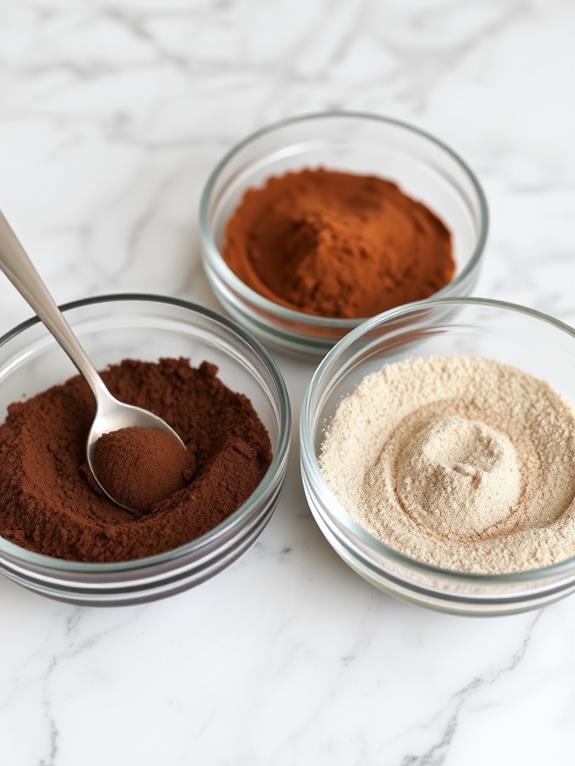
When comparing cacao and cocoa powder, you'll want to examine their nutritional profiles closely. Let's start by looking at the macronutrients and calorie content of each powder, which can impact your overall diet and energy intake. We'll then explore the micronutrients and antioxidants present in both powders, as these components play essential roles in your health and well-being.
Macronutrients and Calories
Three key macronutrients define the nutritional profiles of cacao and cocoa powder: protein, fat, and carbohydrates. When comparing these powders, you'll notice some differences in their macronutrient composition. Cacao powder typically contains slightly more protein and fat than cocoa powder, while cocoa powder often has a higher carbohydrate content.
In terms of calories, both powders are relatively low, but cacao powder tends to be slightly higher due to its increased fat content. For a typical 2-tablespoon serving, cacao powder provides about 60-70 calories, while cocoa powder offers around 40-50 calories. This difference, though small, can be significant if you're closely monitoring your caloric intake.
The fat content in cacao powder is primarily composed of healthy monounsaturated fats, which can contribute to better heart health. Cocoa powder, having undergone more processing, has a lower fat content overall. Both powders are good sources of fiber, with cacao powder often containing slightly more. This fiber content can help support digestive health and promote feelings of fullness, making both options beneficial for weight management when used in moderation.
Micronutrients and Antioxidants
Beyond macronutrients, the real nutritional power of cacao and cocoa powders lies in their micronutrients and antioxidants. Both are rich in minerals, but cacao powder typically contains higher concentrations. You'll find significant amounts of magnesium, iron, and zinc in both, with cacao often boasting 50-100% more of these minerals per serving. Cacao is also a good source of calcium and potassium.
When it comes to antioxidants, cacao powder takes the lead. It's packed with flavonoids, particularly epicatechin and catechin, which are known for their anti-inflammatory properties. These compounds can help protect your cells from oxidative stress and may contribute to heart health. Cocoa powder, while still containing antioxidants, has fewer due to the processing it undergoes.
Both powders contain theobromine, a mild stimulant similar to caffeine. However, cacao powder usually has a higher concentration. This compound can provide a gentle energy boost and may improve mood and cognitive function. Keep in mind that the exact nutritional profile can vary depending on the brand and processing methods, so always check the label for specific information.
Taste and Flavor Differences
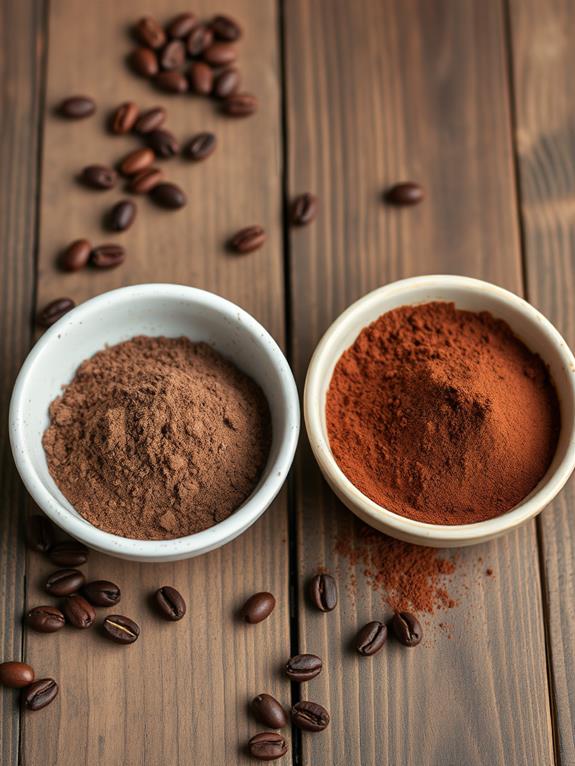
Delving into the taste and flavor differences between cacao and cocoa powder reveals distinct characteristics. You'll find that cacao powder has a more intense, bitter flavor profile compared to its counterpart. This bitterness stems from its minimal processing, which preserves the natural compounds found in raw cacao beans. When you taste cacao powder, you'll notice earthy, fruity, and sometimes nutty undertones that contribute to its complex flavor.
In contrast, cocoa powder offers a milder, sweeter taste that's more familiar to most palates. The Dutch-processing method, often used in cocoa production, reduces acidity and bitterness, resulting in a smoother flavor. You'll find cocoa powder easier to incorporate into recipes without overpowering other ingredients. Its chocolate flavor is more pronounced and less nuanced than cacao powder.
When choosing between the two for your recipes, consider the desired flavor intensity and how it will interact with other ingredients. Cacao powder works well in recipes where you want a bold, rich chocolate taste, while cocoa powder is versatile for a wide range of applications, from baking to hot beverages.
Health Benefits Breakdown
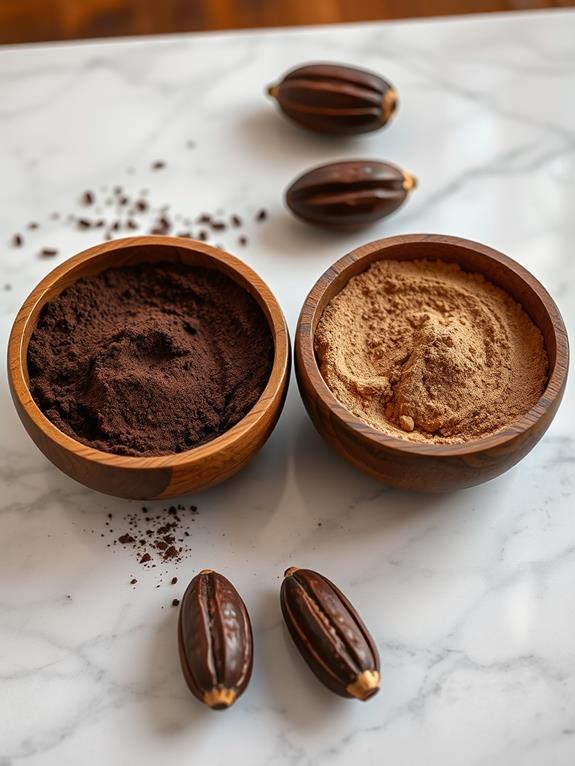
When you're comparing cacao and cocoa powder for health benefits, you'll want to evaluate their antioxidant content and nutrient profiles. Cacao powder typically boasts a higher concentration of antioxidants, particularly flavonoids, which can help protect your cells from damage. You'll also find differences in their nutrient profiles, with cacao generally offering more minerals like magnesium, iron, and zinc, while cocoa powder may have a slightly higher fiber content.
Antioxidant Content Comparison
Concerning antioxidant content, cacao powder clearly outshines cocoa powder. This is due to its minimal processing, which preserves more of the naturally occurring compounds found in raw cacao beans. You'll find that cacao powder contains considerably higher levels of flavonoids, a type of antioxidant that helps protect your body from free radical damage.
When comparing the two, consider these key points:
- ORAC value: Cacao powder typically has an ORAC (Oxygen Radical Absorbance Capacity) score of 95,500 per 100g, while cocoa powder's score is around 26,000.
- Flavanol content: Cacao powder contains up to four times more flavanols than cocoa powder.
- Preservation of nutrients: The cold-pressing process used for cacao powder retains more antioxidants compared to the high-heat treatment of cocoa powder.
Understanding these differences can help you make informed decisions about which powder to incorporate into your diet. While both offer health benefits, cacao powder's superior antioxidant profile makes it a more potent choice for those seeking to maximize their intake of these beneficial compounds. However, it is essential to recognize that cocoa powder still provides valuable antioxidants and can be a more budget-friendly option.
Nutrient Profile Differences
Beyond their antioxidant profiles, cacao and cocoa powders differ considerably in their overall nutrient composition. Cacao powder, being less processed, retains more of its original nutrients. You'll find it's richer in fiber, protein, and healthy fats compared to cocoa powder. It also contains higher levels of minerals like magnesium, iron, and zinc.
On the other hand, cocoa powder, while slightly lower in these nutrients due to processing, still offers significant health benefits. It's often fortified with calcium and vitamin D, making it a good choice for bone health. Both powders are excellent sources of flavonoids, which support heart health and may help lower blood pressure.
When it comes to calories, cocoa powder typically has fewer due to its reduced fat content. However, this also means it has less of the beneficial cocoa butter that cacao powder retains. The processing of cocoa powder can affect its pH level, making it less acidic than cacao powder. This pH difference can impact how your body absorbs the nutrients and how the powder interacts with other ingredients in recipes.
Culinary Applications
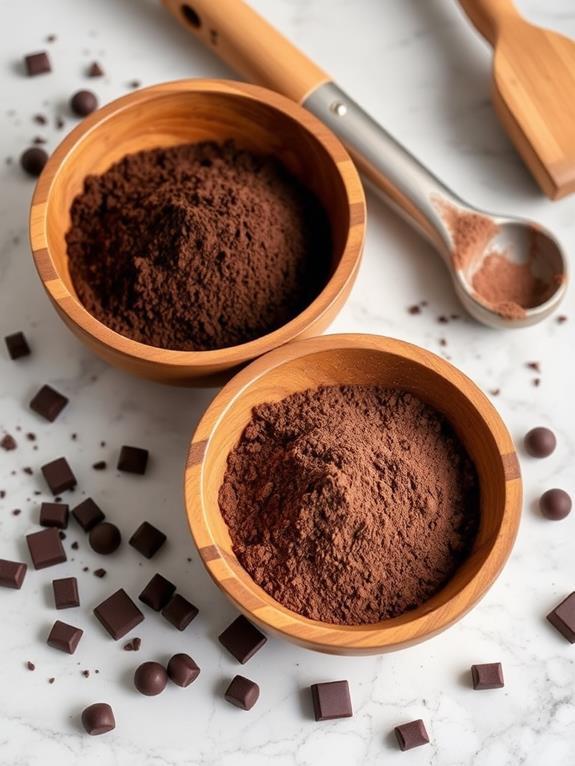
In the kitchen, both cacao and cocoa powders offer versatile culinary applications. You'll find them in sweet and savory dishes alike, but their distinct characteristics influence how you'll use them. Cacao powder, with its raw, intense flavor, is often preferred in health-focused recipes and no-bake treats. It's perfect for smoothies, energy balls, and raw desserts where you're looking to maximize nutritional benefits.
Cocoa powder, on the other hand, is your go-to for traditional baked goods. Its milder flavor and better solubility make it ideal for cakes, cookies, and hot chocolate. When baking, you'll need to adjust your recipe if substituting one for the other, as cacao powder can be more bitter and less absorbent.
Here's a quick guide for using these powders:
- For raw desserts and health drinks: Choose cacao powder
- For classic baked goods: Opt for cocoa powder
- For a balanced approach: Mix the two for depth of flavor
Price and Availability
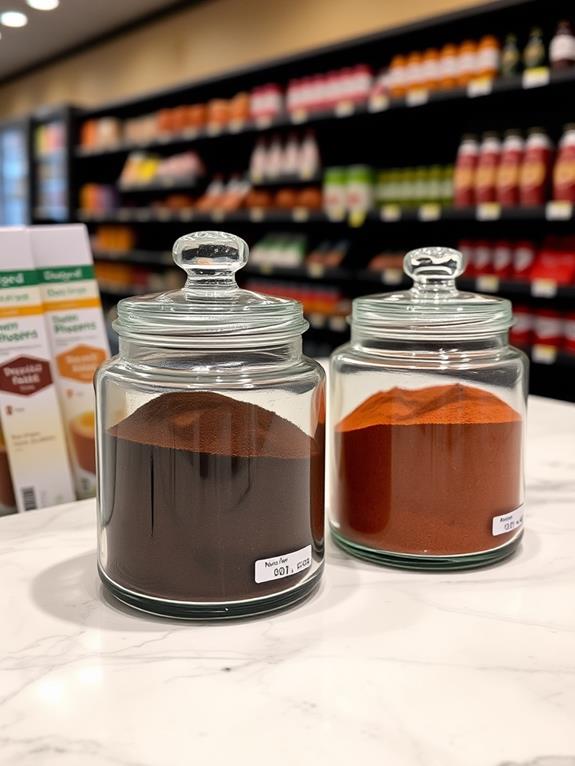
When it comes to price and availability, cacao and cocoa powders differ considerably. You'll find cocoa powder more readily available in most grocery stores, often at a lower price point. It's a staple in baking aisles, making it easily accessible for your everyday cooking needs. Cacao powder, on the other hand, is typically pricier and may require a visit to specialty stores or health food shops.
The cost difference stems from the production process. Cacao powder, being less processed, retains more nutrients but demands more careful handling, which increases its price. Cocoa powder's more extensive processing makes it cheaper to produce in large quantities. When shopping online, you'll notice a wider selection of both powders, but cacao often comes with a higher price tag.
Availability can also vary seasonally and geographically. In regions where cacao is grown, you might find raw cacao powder more readily available and affordable. However, in most areas, cocoa powder remains the more ubiquitous option. Keep in mind that organic versions of both powders tend to be more expensive and potentially harder to find in conventional supermarkets.
Environmental Impact
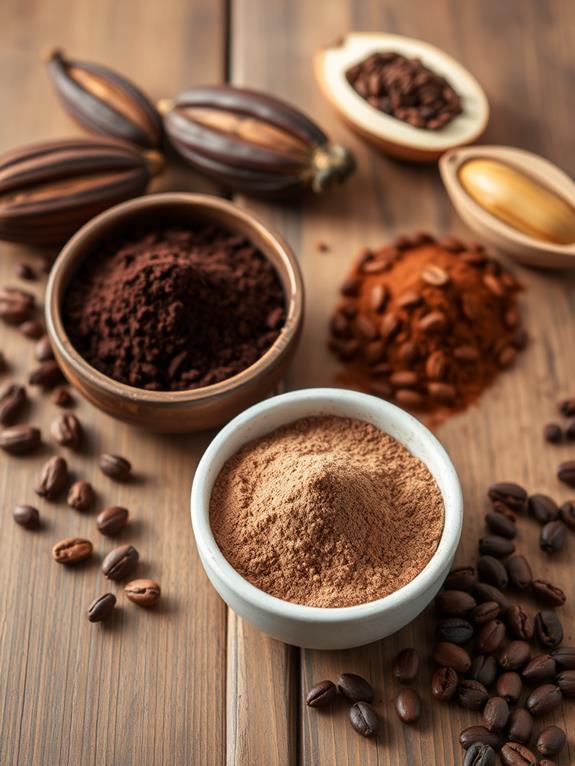
The environmental impact of cacao and cocoa production differs substantially. When you're choosing between cacao and cocoa powder, it's important to reflect on their ecological footprints. Cacao, typically produced using more sustainable methods, often has a lower environmental impact. It's usually grown in diverse agroforestry systems that maintain biodiversity and soil health. Cocoa production, on the other hand, can be more intensive and may involve deforestation and monoculture practices.
To understand the environmental implications, contemplate these factors:
- Land use: Cacao often requires less land clearing, preserving natural habitats.
- Water usage: Cocoa production generally demands more water, potentially straining local resources.
- Carbon footprint: Cacao's agroforestry systems can act as carbon sinks, while intensive cocoa farming may contribute to higher emissions.
You'll find that cacao's production methods align more closely with organic and fair-trade certifications. These practices prioritize sustainability and ethical sourcing. However, it's worth noting that some cocoa producers are adopting more environmentally friendly approaches. When making your choice, research the specific brands and their commitment to sustainable practices. By doing so, you'll be able to make an informed decision that aligns with your environmental values.
Shelf Life and Storage
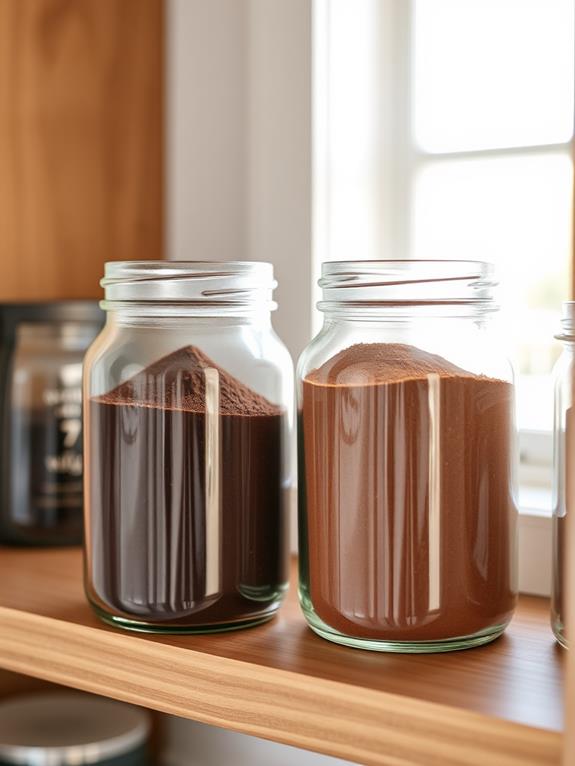
Shifting our focus from environmental concerns, let's consider how cacao and cocoa powders fare in your pantry. Both products have similar shelf lives, typically lasting 2-3 years when stored properly. You'll want to keep them in airtight containers, away from heat, light, and moisture. This storage method helps preserve their flavor profiles and nutritional content. Cacao powder, such as Viva Naturals Organic Cacao Powder, being less processed, may have a slightly shorter shelf life than cocoa powder. However, the difference is often negligible in practical terms. You'll notice that both powders can develop clumps over time, but this doesn't necessarily mean they've gone bad. To prevent clumping, you can add a few grains of rice to the container, which will absorb excess moisture.
When it comes to storage location, your pantry or a cool, dark cupboard is ideal. Avoid refrigerating or freezing these powders, as temperature fluctuations can lead to condensation and potentially spoil the product. By following these storage guidelines, you'll guarantee that your cacao or cocoa powder remains fresh and flavorful for all your culinary needs, whether you're baking, making hot chocolate, or adding a chocolatey boost to your smoothies.
Choosing the Right Powder
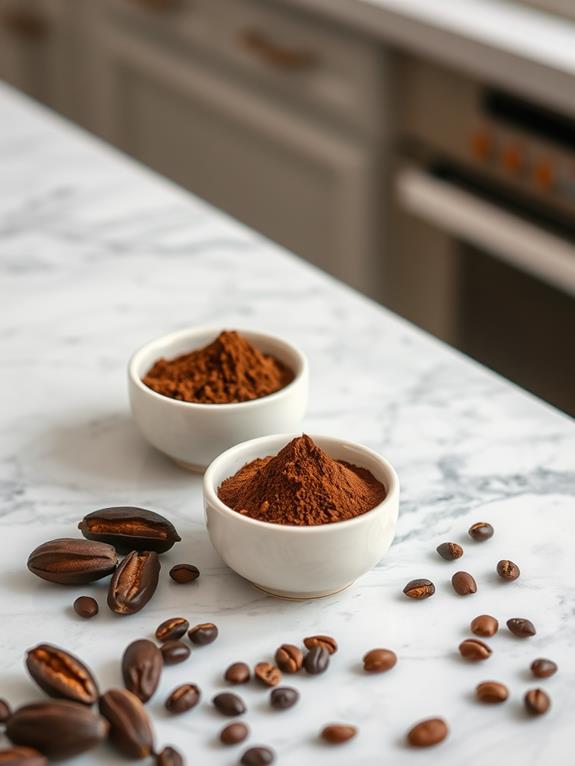
Three key factors should guide your choice between cacao and cocoa powder: flavor profile, nutritional content, and intended use. Consider the taste you're aiming for in your recipe. Cacao powder offers a more intense, bitter chocolate flavor, while cocoa powder provides a milder, sweeter taste. If you're prioritizing health benefits, cacao powder typically retains more nutrients due to its minimal processing.
When selecting the right powder, keep these points in mind:
- Recipe requirements: Some recipes specifically call for cocoa powder due to its acidity and reaction with leavening agents.
- Dietary restrictions: If you're following a raw food diet, cacao powder is the better choice.
- Texture: Cacao powder can be grittier, which may affect the mouthfeel of your final product.
For baking, cocoa powder often yields better results due to its consistent behavior in recipes. However, if you're making smoothies or raw desserts, cacao powder's nutritional profile makes it an excellent choice. Remember, you can substitute one for the other in most cases, but you might need to adjust other ingredients to compensate for differences in acidity and sweetness.





